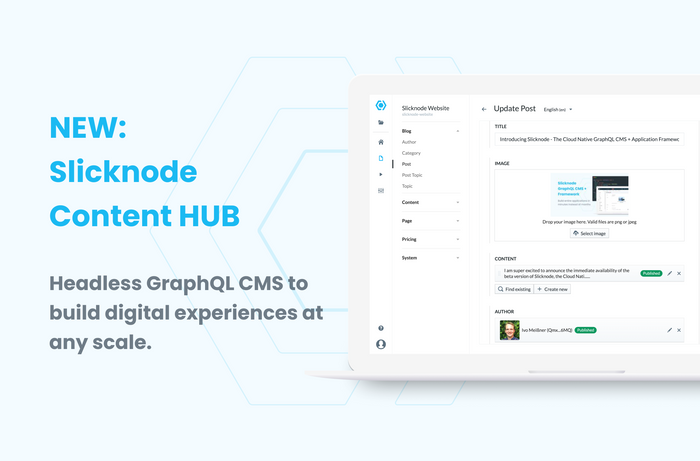November 02, 2020
Announcing Slicknode Content HUB: Headless CMS powered by GraphQL

We have some exciting news to share: After months of hard work, we just launched the new Slicknode that will allow you to build digital experiences with Slicknode better and faster than ever before. The improvements are so profound that they enable an entirely new class of digital solutions that you can build with Slicknode and pretty much change what kind of product Slicknode is.
Here are just a few of the highlights:
- Global GraphQL CDN: Content via the Slicknode API will now be delivered via a global content delivery network that allows you to publish your content to millions of users while at the same time dramatically reducing the latency and response times for API requests around the globe. (In some cases < 20 ms)
- Internationalization: Slicknode now supports localization of your content as a first-class feature that is fully integrated into the query engine, API, and content editing interface. Create digital solutions for global audiences and enter new markets faster.
- Content Preview: There are now two stages for content in your projects, one for editing and previewing drafts and one for the published version. That way, you can make changes and updates to your content without affecting the published version, like agile software development but for content.
- Content Workflows: You can set up custom publishing workflows for your content and collaboratively create content with your team. For example, you can start with a draft version and then move it through your workflow: review > translation > legal > published.
- Union Types: Slicknode added support for union types. With union types, you can now create extremely flexible content models. For example, you can create a modular page builder that can be used by content editors to create dynamic landing pages without involving IT.
- Array Fields: We added support for sortable array fields. While you previously had to create one-to-many and many-to-many fields via a relation, you can now create sortable array fields in which the objects can be sorted via drag and drop in the content editor. This enables a lot of new use-cases, especially in combination with union types.
- New Console: The complete layout and design of the console were updated to improve the editing experience and to support all the new content editing features.
Slicknode now has all the building blocks that you need to create a central hub for all your content. And all those features are 100% backward compatible and are immediately available for all existing projects.
Check out the documentation for more details about the features and how to add them to your existing projects.
New Website
To do the major product release justice, we relaunched a new version of our own website, which is now powered by Slicknode itself. This allows us to publish more content faster and keep the website up to date. We now have a modular content builder for building pages and creating an interactive experience to learn about our product.
If you want to build a similar website for your own company, check out our…
Next.js Starter Kit
We created a Next.js starter kit that you can use to quickly set up a website with Slicknode, Next.js, static site generation, etc. in a few seconds.
Updated Pricing
With the release of the new Slicknode Content HUB, we also updated and simplified our pricing model. We now have a “Free forever” plan for development, small websites, or experiments, and you can save money by paying annually. Check out the pricing page for details.
Future Direction
This launch marks a significant milestone in the history of Slicknode: When we first started building Slicknode, we set out to create a solution that automates the repetitive work that is still required to create high-quality custom software solutions. We created a general-purpose backend that is up and running in seconds without developers having to worry about setting up infrastructure, databases, running migrations, etc.
Having such a general-purpose solution allowed us to gather valuable feedback from customers for a wide variety of use-cases and see for which solutions they considered Slicknode. We want to thank all of our customers and users for their valuable ideas and feedback, which helps us make the best decisions about how to improve our platform.
The one thing that stands out is that most customers are using Slicknode for content-centric applications. It just made sense to focus most of our efforts on adding essential functionality for managing and distributing content, like adding a global CDN, localization support, and custom content workflows. Since Slicknode was initially built for highly complex applications that go way beyond what you would usually use a CMS for, you now have a platform that has a lot more functionality out of the box than a lot of other content management systems on the market today.
We will continue to improve Slicknode for content management use-cases and would love to hear your feedback and ideas (Join us in our Slack channel).
